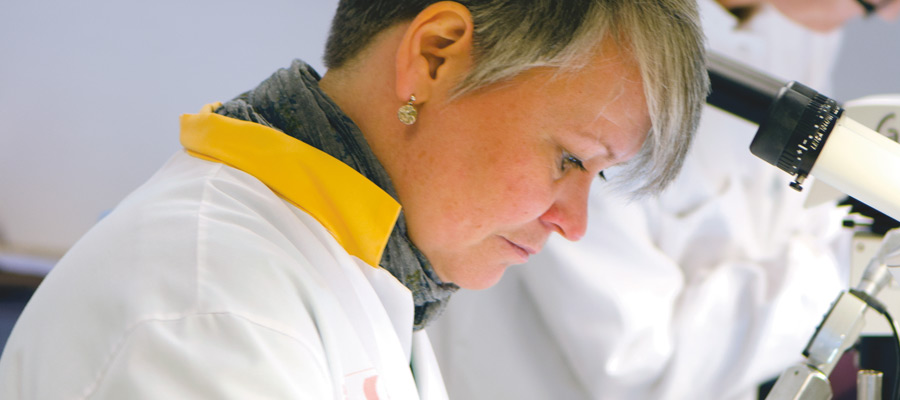
Malin Johansson, a researcher at the Department of Medical Biochemistry and cell biology, Sahlgrenska Academy, studying tarmmukus at ranging from biochemical level to how the interaction works in all biological systems. NOTE – This article is machine translated from Swedish.
In the past it was believed that the intestinal mucous layer was a gelmassa who happened to be in the intestine but actually function. Now we know that bowel mucus, or mukuslagret, is very complicated structured, has several important features and produced by various cells. If it isn’t working properly, it can lead to both inflammatory diseases and cancer.
Yet the field is relatively unexplored, which helps to make it exciting, like Malin Johansson, a researcher at the Department of Medical Biochemistry and cell biology, the Sahlgrenska Academy. In addition, the terms of which she complicated method, with background as a biomedical scientist like. That is, among other things, mukus svårstuderat with the size to make.
– They are extremely large and contain a lot of carbohydrates that binds large quantities of water making it a gel. In addition, they form multimerer, which results in extremely large complex.
It does not appear to be so as previously thought, to intestinal cells themselves can distinguish and protect themselves from bacteria. Malin Johansson’s research team has discovered that it instead seems to be that tarmmukus forms a barrier against both benign and pathogenic bacteria so that they do not reach the intestines without being held in lumens.
Mukus in thin and thick arm differ. In the small intestine, it acts as a diffusion barrier with a gradient of antibacterial substances in highest concentration next to intestinal cells. It is there, that is to say at the bottom between the intestinal luddets Committee, the cells that produce these substances is densest. This is also where the mukusproducerande cells, gobletceller, is that most densely. In addition to producing mukus, they also up bacteria or parts of bacteria from the intestinal contents and present to cells in the immune system.
In the colon, however, should the cells be fully protected from bacteria. When the bowel contracts to empty itself is the mechanical stress significantly and without an effective barrier protection would most likely bacteria are squeezed into the tissue and cause damage in different ways, think Malin Johansson.
– Pathogens have mechanisms to be invasive, i.e. to enter the cells and do damage. Common bacteria, lactic acid bacteria, for example, does not have the ability but I think we would react to them also if they made their way to the intestinal cells. It is in tarmlumen they do benefit. In animal models, for example the effects of damaged mukus on different systems which could be linked to obesity and diabetes. With a low-grade inflammation is put processes that change probably started the thresholds for fat and insulin resistance.
Have secretion turned on all the time
A disease that is interesting to look at if you want to understand the function of mukus is the inflammatory bowel disease unclerös colitis. Normally there is a small basalsekretion of mukus. This can be increased in emergency situations in order to rinse away intruding bacteria for example, but then have the system recover. Patients with active Ulcerative colitis, on the other hand, have turned on all the time. secretion
– In these patients tire system out and bacteria can travel to, and into the tissue. The cause of the disease is not known, but interesting is that it always starts in the distal colon, that is at the bottom of the large intestine, which is where barrier protection against bacteria are likely to be at its most important.
Important to understand the underlying cause
Malin Johansson is studying how tarmmukus looks at the different stages of the disease. When she compares patients currently doing well with patients who are in an active phase of the disease, she sees that those who are sick have faulty mukus while those who are currently healthy are normal. Not so surprising, perhaps, but what she has discovered is that even among the currently healthy are a group who have defective mukus.
– After all, one wonders then if they would get sick if something triggered the process, and if it is the case that there is a group that has always defective mukus regardless of whether they are sick or healthy. For patients, it is important that we begin to consider the underlying causes so that we can group them and in this way create specific treatment. A group might be helped by treatment that strengthens mukusskyddet, while another by a treatment that boosts the immune system. Many diseases are defined by their symptoms, but the cause of the disease need not be the same for it. It’s probably much more heterogeneous.
Even tumor development in the gut may have with mukusdefekter making. In the past it was thought that there must be an inflammation to cancer would evolve but Malin Johansson do not believe that this is the case, but rather that it sometimes becomes inflammation and sometimes cancer.
“You can speculate it may be different bacteria that cause one or the other or to different cells react differently to the same bacterium. In mice lacking mukus, it has been seen that there is increased cell division which means a cancer risk but it also produces inflammation. It is also looking to gut the feather will be higher in patients with mukusdefekter which is the result of increased cell division.
Allocation of Lundbergsstiftlesen will be put into a cell sorter, a FACS. The group will examine the function of various kinds of mukusproducerande cells. Here comes a mouse model with red tarmslem enters the picture. Because it is red, it’s easy to see where that goes, and with the help of the mice, they can study both cells that produce mucus and cells that take up the associated with that material from the tarmlumen presented to the cells of the immune system.
